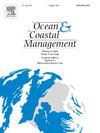Effects of different wave calculation methods on groundwater flow and salt transport in coastal aquifers under irregular waves
IF 5.4
2区 环境科学与生态学
Q1 OCEANOGRAPHY
引用次数: 0
Abstract
This study evaluates the Nielsen set-up empirical equation's applicability for groundwater dynamics under irregular waves through numerical simulation, comparing phase-resolving and phase-averaged methods under three peak enhancement factor (γ) conditions. Key findings demonstrate that both numerical methods generate stronger horizontal pressure gradients than the empirical equation, yielding larger upper saline plume (USP) features (area, salt content) and greater saltwater penetration depths. The phase-averaged method produces more persistent pressure gradients, resulting in enhanced USP characteristics compared to the phase-resolving method, which promotes broader salt-freshwater mixing through wave-induced water level fluctuations. Reduced γ values correlate with more uniform wave energy distribution, amplifying swash extent and pore pressures, thereby intensifying USP quantities and method-dependent discrepancies. Interface flux analysis reveals phase-averaged conditions yield higher peak infiltration (30 % greater) and marginally stronger submarine groundwater discharge (SGD) than phase-resolving results, with γ reduction further accentuating these differences. The set-up empirical equation consistently underestimates flow and salt dynamics by 21∼53 % across main metrics (USP area: ∼53 %; mixing area: ∼49 %; SGD: ∼24 %; total influx: ∼21 %), demonstrating its unreliability for wave-groundwater coupling systems. These findings strongly support the need for physics-based numerical approaches in coastal aquifer management, particularly for regions experiencing intensified wave variability. The study establishes γ as a key modulator of USP dynamics and method selection criteria for subsurface transport modeling.
不规则波浪作用下不同波浪计算方法对沿海含水层地下水流动和盐运移的影响
通过数值模拟,比较了三种峰值增强因子(γ)条件下的相位解析法和相位平均法,评价了Nielsen建立的经验方程在不规则波下地下水动力学中的适用性。关键发现表明,两种数值方法产生的水平压力梯度都比经验方程更强,产生的上部盐羽(USP)特征(面积、含盐量)更大,盐水穿透深度也更大。相位平均法产生更持久的压力梯度,与相位分解法相比,USP特性增强,后者通过波浪引起的水位波动促进了更广泛的盐-淡水混合。减小的γ值与更均匀的波能分布相关,放大了倾斜程度和孔隙压力,从而加剧了USP量和方法相关的差异。界面通量分析显示,相平均条件比相分解结果产生更高的峰值入渗(高出30%)和略强的海底地下水排放(SGD), γ的减少进一步加剧了这些差异。建立的经验方程在主要指标(USP面积:~ 53%;混合面积:~ 49%;SGD: ~ 24%;总流入量:~ 21%)上始终低估了21 ~ 53%的流量和盐动力学,证明了其对波-地下水耦合系统的不可靠性。这些发现有力地支持了在沿海含水层管理中采用基于物理的数值方法的必要性,特别是在经历波浪变异性加剧的地区。该研究建立了γ作为USP动力学的关键调制器和地下输运建模的方法选择标准。
本文章由计算机程序翻译,如有差异,请以英文原文为准。
求助全文
约1分钟内获得全文
求助全文
来源期刊

Ocean & Coastal Management
环境科学-海洋学
CiteScore
8.50
自引率
15.20%
发文量
321
审稿时长
60 days
期刊介绍:
Ocean & Coastal Management is the leading international journal dedicated to the study of all aspects of ocean and coastal management from the global to local levels.
We publish rigorously peer-reviewed manuscripts from all disciplines, and inter-/trans-disciplinary and co-designed research, but all submissions must make clear the relevance to management and/or governance issues relevant to the sustainable development and conservation of oceans and coasts.
Comparative studies (from sub-national to trans-national cases, and other management / policy arenas) are encouraged, as are studies that critically assess current management practices and governance approaches. Submissions involving robust analysis, development of theory, and improvement of management practice are especially welcome.
 求助内容:
求助内容: 应助结果提醒方式:
应助结果提醒方式:


